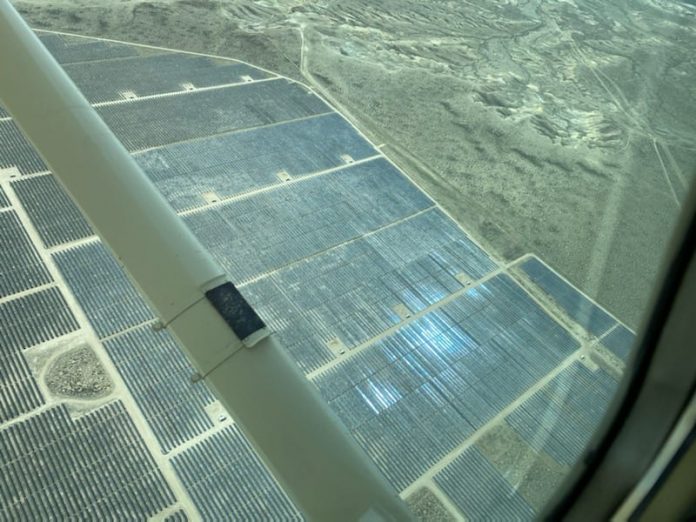The Natrona County Board of County Commissioners (BOCC) voted Tuesday, June 2, to approve a conditional use permit for Dinosolar and its parent company ENYO to build a 240-megawatt (MW) capacity solar farm on 2,150 acres of leased private land just west of Bar Nunn and north of Casper.
This would be be by far the biggest solar farm project in the state. The next largest, the Sweetwater Solar Energy Project, generates 80-MW.
At issue was existing regulation requiring that solar panel arrays be set back from residential zones by 1.25 miles, as drafted for the Sweetwater project. The BOCC ultimately approved a variance to reduce the setback from residential zones to 500 feet to accommodate the Dinosolar project.

Christine Mikell, Dinosolar’s project leader, said value of the completed project would be $240 million. Construction project would employ 116 workers, 25% of whom could be sourced locally. She said the project would generate over $2 million dollars in property taxes in its first year, and $8.7 million in sales and use taxes during construction.
Commissioner Forrest Chadwick estimated that 62-70% of the property tax revenue would go to the Natrona County School District. Mikell also said that the project might attract firms like Facebook to set up data processing centers in the area.
Construction would begin September 2021 and take about a year.
Mikkel’s presentation included photos of the existing landscape with renderings of the panels would be nearly invisible within the topography. She also presented mitigation strategies for blowing dust during construction, and cited a review by the Wyoming Game and Fish Department did not identify any risk to game, sage grouse, or cultural or historical resources.
The combined 240-MW solar farm would connect to the power grid through the Bar Nunn electrical substation to the north, and the Casper substation to the south. An agreement to sell the electricity to Rocky Mountain Power would be one step closer with the granting of the permit, Mikell said.
The panels would rotate throughout the day to remain perpendicular to the sun, but “park” at 5-degree angle in the morning and at night to reduce glare at those times.
Still to be determined is how as many as 24 trucks per day carrying building materials would access the site. “The most desirable [option] is a non-residential access,” said Commissioner Forrest Chadwick. One of the three proposed access routes would use Melody and Andy Lanes in Bar Nunn. “That street is full of kids, and I just don’t think that’s a good mix.”
“If you have enough concerns, that could be grounds to deny the application,” said Natrona County Attorney Eric Nelson.
The other two options involve construction of roads to county specifications. One route would be off of Foreman Lane, just north of the Port of Entry. Another option would follow the route of the already-proposed Westwinds Road, which would connect Bar Nunn to Commerce Drive and the Casper-Natrona County International Airport (CPR).
Another concern of Chadwick’s was that Dinosolar might be exempt from pending legislation in July regarding industrial siting for solar projects. Industrial citing allows the counties to keep a greater percentage of the sales-and-use taxes that would otherwise go to the state to cover possible hidden costs to the county involved in the construction that might include unpaid deductibles at hospitals for injuries incurred or loss of lodging tax revenue as long-term construction workers effectively become renters.
A sticking point discussed at length involved concerns about glare from the panels and hazards it might present to the pilots and control towers at the CPR. Mikell presented the findings of a Federal Aviation Administration review, saying there is no hazard.
She said that the solar panels are designed to absorb sunlight, and are less reflective than metal roofs and bodies of water that pilots encounter regularly. Pilot Chester France also spoke to the board and said that “Glare is not an issue,” adding, “The system works.”
Some residents, including a combat pilot veteran, voiced skepticism of the findings, and the board considered whether the study accounted for all possible flight pattern scenarios. “I imagine it would be a nearly infinite task,” said John Materson, also representing Dinosolar.
County Attorney Eric Nelson said that under CUP20-20, the board had the implicit ability to revoke the permit if hazards became apparent. “From a county standpoint, and by extension, the airport, I think we’re as protected as we possibly could be,” he said.
After discussing the issue of due diligence and glare hazards at length, Chairman Rob Hendry, a fixed-wing and helicopter pilot, reported his personal findings after flying a personal aircraft around the solar farms around Rock Springs and Green River. “I flew around til I found the glare, and I could look directly at it.” He added that the glare off Goldeneye Reservoir was a lot brighter. “I wanted to see for myself, and I tell ya, I don’t think it’s a problem.”


As the board approved the permit and variance, Chariman Hendry said “Another reason I’m for this is they’re talking about closing Dave Johnson Power Plant. Someday we might be damn fortunate to have [the solar farm’s] power generated right at our doorstep.”






